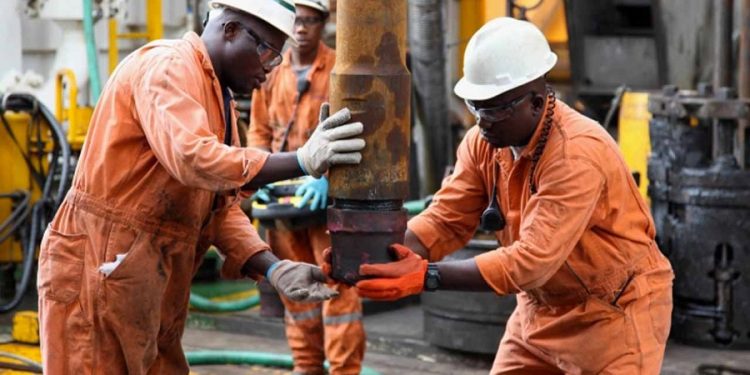Nigeria’s economy begins to shift as the oil industry rebounds, Findings across performance benchmarks show signs of a sector revival.
There are signs that Nigeria’s economy is reverting to an oil-driven development model, with gains in the non-oil sector reversing.
However, the Organization of Petroleum Exporting Countries, or OPEC, has signaled that a new challenge to the country’s new strength in the crude oil sector has begun to emerge.
Findings across performance benchmarks show signs of a sector revival, including increased rig count, recoveries at several oil terminals, the launching of new oil wells, and stable export pricing.
The average rig count, an index of measuring activity in the upstream sector, increased by 62% year on year, YoY, to 15 between June and October 2023, compared to nine in the same period in 2022.
According to a month-by-month analysis of OPEC data for the five-month period June – October 2023, Nigeria’s rig count was 16, 14, 18, 15, and 13 in June, July, August, September, and October 2023, respectively.
This is a big improvement above the 11, 11, 10, 7, and 8 recorded in June, July, August, September, and October 2022.
The group did not explain the underlying forces, but Vanguard checks revealed that stakeholders, particularly investors, have continued to respond positively to Nigeria in the post-Petroleum Industry Act, PIA regime.
Former President Muhammadu Buhari signed the Petroleum Industry Act (PIA) into law in order to restructure and reposition the oil and gas industry for new investments while improving transparency and accountability.
Oil output has increased to 1.4 million barrels per day
The country’s oil output has increased by more than 40% from a low of less than one million barrels per day (mbpd) last year to 1.45 mbpd in October 2023.
This indicates that when condensate is included, which Nigeria can generate between 300,000 and 400,000 bpd, the nation’s total output will exceed 1.6 million bpd.
Major oil terminals performed well in the third quarter of 2023, according to data from the Nigerian Upstream Petroleum Regulatory Commission (NUPRC).
Forcados terminal increased by a staggering 6,028.5% year on year, while Bonny increased by 1,875.7%, Brass increased by 245.5%, and Escravos increased by 24.0%).
For the first time in recent years, all other terminals reported an increase in production.
The Effect of Nembe Crude
The resumption of production and shipment of Nembe crude by the NNPC/Aiteo Joint Venture has had an impact on the country’s total oil output.
The Nembe Crude Oil Blend was revealed at the recently concluded Argus European Crude Conference in London by Aiteo, the operator of the NNPC/Aiteo Oil Mining Lease, OML 29 Joint Venture, JV.
The OML 29, which was purchased from Shell in 2014, was previously blended with the popular Bonny Light grade and shipped through the Bonny Oil & Gas Terminal.
Already, two cargoes of 950,000 barrels of Nembe Crude Oil grade have been exported to France and the Netherlands, signaling the start of operations at the Nembe Crude Oil Export Terminal, NCOET, which was licensed in accordance with existing laws and Crude Oil Terminal establishment regulations.
Europe is enthralled with Nigeria’s oil
Maryamu Idris, Executive Director, Oil & Condensate, NNPC Trading Limited, stated in a panel discussion at the recently completed Argus European Crude Conference in London that Nigerian oil flow to Europe has grown in an effort to address supply gaps caused by the Russian crude ban.
She said that 678,000 bpd of Nigerian crude grades were sent to Europe six months before the Ukraine war, compared to 710,000 bpd six months later and 730,000 bpd so far this year.
According to her, “This trend makes it evident that Nigerian grades are increasingly becoming a significant component in the post-war palette of European refiners. Several Nigerian distillate-rich grades have become a steady preference for many European refiners, given the absence of Russian Urals and diesel. Forcados Blend, Escravos Light, Bonga, and Egina appear to be the most popular, and our latest addition — Nembe Crude – fits well into this basket. This was a strong factor behind our choice of London and the Argus European Crude Conference as the most ideal launch hub for the grade.”
According to her, NNPC Limited has formed critical alliances with prominent financial institutions in order to encourage upstream projects that would restore and sustainably enhance production capacity in the future years.
Analysts’ insights
Giving their perspectives on the impact of the development in the oil sector, analysts at Afrinvest West Africa, a Lagos-based investment house, stated: ”Following expectations of a continued increase in oil production, we anticipate the oil sector would play a larger role in contributing to the overall real GDP for the full year of 2023.
”Also, ramping up oil productions to levels around 1.8mbpds would position Nigeria to capitalize on potential exchange rate revaluation gains from crude oil sales”.
Also commenting, economists at CardinalStone Capital, another Lagos-based finance and investment firm, stated: ”Looking ahead, we expect the oil sector to exit a recession in Q4’23, as we anticipate a sustained improvement in oil production, settling at 1.50mbpd”.
”Higher oil output translated to improved quarter-on-quarter, QoQ, GDP performance of 2.6%.”
Non-oil sector reverses trend
But while the oil sector is recording a massive rebound, growth in the non-sector has reversed.
Giving insight into this development, analysts at CardinalStone stated: ”The weaker growth in the non-oil sector may have stemmed from the dual actions of the CBN. First, the CBN pulled back from the direct development finance interventions orchestrated by the former CBN leadership.
”Given that a significant portion of CBN’s development finance is concentrated in the Agriculture sector, the stoppage, coupled with pre-existing issues like insecurity, might have constrained the sector’s outturn, whose growth (+1.30% YoY) recorded the lowest Q3 performance on record.
”The second action of the CBN was the sustained hawkish rendition, which resulted in material increases in the domestic interest rate.
”This elevated borrowing rate might have dampened sentiment in the Manufacturing sector, which recorded a marginal increase of 0.48% YoY (vs. 2.20% YoY in Q2’23).
”In addition, the lingering currency pressures further stoked the weak outturn in the manufacturing sector, as we note that 60.00% of companies on the NGX 30 have significant FX needs.
The OPEC challenge
Meanwhile, the OPEC and non-OPEC Ministerial Meeting, ONOMM, predicted Nigeria’s oil output at 1.5 million bpd in 2024, implying that a production cut would reduce Nigeria’s quota to 1.5 million bpd, down from 1.8 million bpd.
This comes at a time when Nigeria had built her economic recovery and fiscal plan for 2024-2026 on a high output level of between 1.7mbpd and the present OPEC quota of 1.8mbpd.
“In accordance with the decision of the 35th OPEC and non-OPEC Ministerial Meeting, the completion of the assessment by the three independent sources (IHS, Wood Mackenzie, and Rystad Energy) for production level that can be achieved in 2024 by Angola, Congo, and Nigeria as follows: Angola at 1,110 t/bd, Congo at 277 t/bd and Nigeria at 1,500 t/bd,” said ONOMM.















